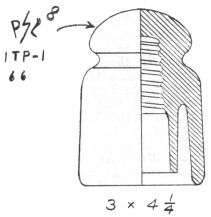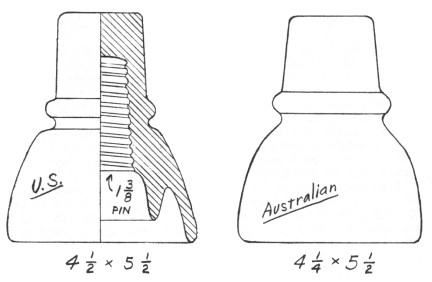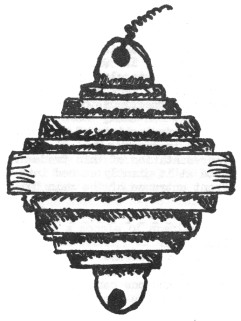Porcelain Insulator News
by Jack H. Tod
Reprinted from "INSULATORS - Crown Jewels of the Wire", November 1977, page 17
Dear Jack:
I have just picked up a new white-glazed insulator on a recent
trip to New Hampshire and would be interested in finding some information on
it.
It is very well made and the pin hole is just large enough for a wooden pin.
It has an underglaze marking (blue ink), and I've sketched it actual size as
close as I could. The "8" is a separately incuse-stamped number. The blurred
element at the bottom could be a "66". The central element in the top of the
marking could be a "2" or "Z", but it is blurred somewhat.
Arthur E. Jones
Newcastle, Maine

- - - - - - - - - -
Dear Arthur:
Judging from the insulator style, and especially from the
marking, l'd say this is a foreign insulator -- most probably Canadian or New
Zealand. I think the marking item between the P and L is a lightning bolt symbol.
Once again, help! Will one of you readers please write and tell us
what this insulator is, who made it, etc.?
Jack
CORRECTION
It's well known to the local folk that I scratched while shooting at the 8
Ball back in 1951, but now I've made a second error. In the September 1977 issue,
near the bottom of page 31, the years "1918-1936" should be "1928-1936".
Surely all you Locke fans noticed this typo error.
Dear Jack:
On pages 17-18 of the May 1975 issue of Crown Jewels you gave your
readers a good rundown on F. N. Gisborne and his insulators. In follow-up to
this, we have for you some "good" news -- and some "bad"
news.
The good news is we are the proud owners of a large, white porcelain
insulator which we have dubbed the "Gisborne Grandaddy". One of the
enclosed pictures shows it between a regular Gisborne and the Battleford Baby.
It is 4-5/8" wide, 7-1/4" tall, has a 2-1/2" threaded pin hole, a
top groove, and a 3/8" tie-wire hole through the dome. Wouldn't you agree
that this is a unique design? The words "GISBORNE PATTERN" are incised
on the side in the same lettering as one of the standard-sized Gisbornes (small
block letters, words in one line).
Now the bad news. After over a year of research we are unable to tell you for
what specific purpose it was used, where or when! We also do not know of any
other collector who has one. The quality of the porcelain and the design of the
base makes us believe it could be English made....
We would certainly be interested in knowing if anyone has written to you
about this unique design or if any of your readers could help out with some
information.
We look forward each month to your very interesting articles in CJ,
and sincerely hope this A1 publication will continue to tie the collectors'
world together.
Len & Dot Elder
10815 - 42 A Ave.
Edmonton, Alberta T6J 2P6
Canada
- - - - - - - - -
Dear Len & Dot:
Many thanks for this report of a very unusual insulator, and the photos are
super nice. I 'm sure this will really excite a lot of collectors, and
especially those in Canada who have such fine collections of Canadian items --
and who may think they'd found every new goody there was to find! Hopefully
someone out there in insulatordom might have information on the "Gisborne
Grandaddy".
Jack
Gerald Brown (Two Buttes, Colo.) advised that N. R. Woodward (Houston)
found a green U-179. That's almost hard to believe, but then Woody seems
to have a knack for coming up with spectacular finds.
Dear Jack:
... You no doubt remember our discussions on the possibility of U-223
two-piece white porcelain and CD-190/191 purple glass transpositions on the line
to Churchill on Hudson Bay. I talked to two CN communications linemen who have
worked that line, and both denied the existence of these insulators on this
line. This line should be in the process of being dismantled now. I talked to
the lineman of the crew that will be taking it down, and he will be watching for
them, but he was one of the linemen who had worked that line in the past. Also
had the opportunity to discuss this with Mrs. Wittstock (where the info came
from originally). She was quite vague about it all, so I didn't push it.
I sure agree with your sentiments of last winter regarding somebody up here
researching Canadian porcelain. There sure is a scanty amount of info, and what
info there is, is of the word of mouth variety, vague and often inaccurate. I
don't suppose it will ever happen, if it hasn't happened by now. It's a job I'd
like to tackle but I don't think, and you would probably agree, it's a job that
could be done by someone working full tine and raising a family. I'm at least 10
years from retirement. But it would be a challenging and interesting task.
Have been kind of concentrating on my porcelain collection lately. Have
picked up dozens of unmarked porcelain, many of which look like Canadian items,
but no way of knowing for sure. The field hasn't been touched.
Have picked up a lot of nice U.S. porcelain items lately too -- nice old
Lockes, glazewelds, etc.
Also picked up a U-365, traded to me as the Australian version, which it
probably is. Have never seen the U.S. version. Is there a difference between
them, some way I can be sure mine is the Australian one?
I've been going to ask about an insulator for some time. It's fairly common
up here and is generally considered to be a Canadian item, and it probably is.
It is similar to U-438B. It exists in a wide variety of mottled brown glazes
ranging from reddish thru the browns to blackish, and also in cobalt blue. My
reason for being curious about it is that the glazes used are much more like
glazes used by various U.S. companies and have little resemblance to glazes on
most Canadian-made items. Anyway you may be familiar with it.
My next question is about the C.N.R. and C.P.R. white beehives made by
Pittsburg High Voltage. Which ones? The older varieties with the crude incised markings
have PHV characteristics, so they no doubt were. Other incise-marked varieties, with clear block letters and of larger size, don't appear to
have
PHV characteristics. The underglaze-marked types don't look like PHV items
either.
Pittsburg must have really gone after the Canadian market. I'm sure
that at least 3/4 of the U.S.-made porcelain found up here are PHV.
Keith
Ewart
Moose Jaw, Sask., Canada
- - - - - - - - -
Dear Keith:
I know very little about the origins of the various U-365 insulators -- one allegedly from Australia and the other from U.S. locations.
My only info is from what Jerry Turner (Ohio) and several others have told me.
As I
recall it, collectors first got these on trades from Australia, now referred to
as the Australian version. Regarding the U.S. version, Jerry told me in1973
that these were "Said to be from the first electric trolley line in Seattle,
Washington." I was also told that one of these in a California collection
was dug by antiquers near Ione, Nevada.
You will find on page 24 of the June 1974 CJ Jerry's photo of both versions side by side. The
drawings below are also
from Jerry's data, and it should be easy for you to tell from these drawings
which one you have. Jerry didn't mention the pin hole size in the Australian
one.

If your Sim U-438B items are U.S. manufacture, I'd guess they were Pittsburg.
You could tell that (usually) by looking at the pin hole. Most Pittsburgs have
unglazed pin holes with a perfectly flat top, but occasionally with the top having
concentric rings progressively deeper towards the center.
You are correct that Pittsburg sold heavily in Canada, and they also
"job shopped" in the U.S., selling custom items to anyone who wanted them -- notably railroads. We have
determined by dump digging near the old Pittsburg
plant that they made both C.N.R. and C.P.R. beehives, and with both the incuse
and underglaze markings. Unfortunately I did not make records of which specific
combinations were represented. The ones by Pittsburg are reasonably crude, as
compared with ones made in Canada or England. They do have the characteristic
shape at the bottom rim, but they also have the characteristic Pittsburg pin
hole -- unglazed, flat top, etc.
U.S. companies (Imperial, Locke, and then
Pittsburg) did furnish most of the porcelain insulators to Canada for many years
until porcelain companies became firmly established in Canada, the first of
which was Canadian Porcelain Co. founded in 1912. It's no wonder then that many
early U.S. classics can be found on old lines up your way.
Jack

Dear Jack:
A bottle digger friend just dug up a small strain insulator, a
sketch of which I'm enclosing. It's a mottled shiny brown -- very pretty. I
would like any information you might want to give on this.
Tom Kasner
Bend,
Cregon
- - - - - - - - -
Dear Tom:
Your insulator is a radio antenna strain, and we showed this in the
April 1976 CJ, page 20. Walter Lehnert (Minneapolis), our researcher and
authority on radio antenna insulators, found this in a 1915 catalog of Electro
Importing Co., and some of their items bear an EICO marking.
This petticoated
strain is a rather unusual style, and they are probably a goody to collectors of
radio strains. I have no idea of whether or not they are scarce, but my hunch is
that they are.
Jack

The marking shown at the right is that of Lapp Insulators, Inc. This is
their official trademark, registered (#140,418) March 15, 1921 and used by Lapp since
May 1, 1919.
This is "old hat" info to porcelain buffs, but
is misunderstood by other collectors reporting to us on Lapp insulators.
The marking is the company's initials in monogram (L. I.) within an oval.
We
wish to clarify this, since within the space of one week two readers reported
having unmarked specimens, but which had a "4 within a circle" on
them. Some Lapp handstamps are only approximations of this design, but it's
still meant to be the trademark, Oval-LI. If you wish to see a beautiful
representation of this trademark, visit the Lapp plant and gaze at it
giantly etched into the plate glass doors at the front entrance of the main
building.
Jack
Dear Jack:
.... and please "unconfuse" me on "glazewelds". All
my specimens of U-935 are clearly marked with the Imperial handstamps, and
one cannot detect any sign of glazeweld here. I'm sure these are all one-piece as
you show too.... Etc.
Bob Reyburn
Ontario, Calif.
- - - - - - - - - -
Dear Bob:
It is not always easy to tell that the items are made up of two or
more parts by glazewelding. This is especially true on the Imperial items, but
it also goes for some Thomas and Fred Locke items. During roughly the 1897-1899
period, all these companies were just setting the shells into one another upside
dawn and filling in all the cracks and crevices with generous amounts of glaze slip.
Upon firing, it's nearly impossible to
detect any signs of glazewelding. Again, this is especially true on Imperials.
I have same Imperials which you'd swear were made one-piece, but it just
figures from their size and vintage that they would have to have been made by
glazewelding.
I know that U-935 usually has no trace of glazewelding (and I've
looked closely at many of them), but the specimen I have before me does have
evidence of being a glazeweld -- no open cracks etc., but still you can see
where considerable extra glaze slip was poured in. It's also ever so slightly
different in color and sheen than the glaze on the insulator body in the same
area.
Regarding items in the Style Chart such as U-923, U-923B, U-923C, U-923D,
U-924, U-935, etc. not showing the probable glazeweld joints, that's simple.
First, at
times I just got tired of trying to dream up what the various parts (&
joints) would look like. Secondly, at one time I myself wasn't 100% convinced
that some of these medium-sized insulators were actually glazewelds (even though
listed in catalogs as made from more than one part by glazewelding), so I got
leary about dreaming up glazeweld juncture lines that might not actually be
there.
This "not being 100% sure" thing also caused things such as U-713
(an Imperial) being back on page 76 of the Chart instead of being up in the
U-922 to U-966 part of the Chart where all the glazewelds are shown.
So we get
back to the question that we think all of the early items of moderately large
size were glazewelds, but we aren't certain. It would be easy to tell for
certain by just sectioning specimens, but who wants to put nice Imperials under
the lapidary saw just to satisfy curiosity? So it boils down to this; we just
say we have an Imperial U-713, and that's good enough -- and definitive for
listing.
Similarly, I have always thought that the U-186 "twist-lock" was made by glazewelding the crown portion onto the base portion,
and I've seen at least a couple of specimens which had slight evidence (but not
convincing) of a glaze-weld juncture just under the crown. Even the most damaged one in collector circles was still too good to saw apart for this
purpose. Curiosity has its limits!
Jack
Arthur Jones (Newcastle, Maine) has a Sim U-608A with a Fred M. Locke
handstamp marking on the skirt. There's nothing unusual about that. BUT, guess
what? It is a white one, and that's certainly big news for Locke fans. Fred
Locke cataloged the #12 as available in either brown or white glaze, but I'd
never heard of a white one until Arthur reported having this one.
| 